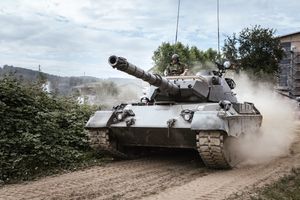Afghanistan: A Testing Ground for Miscellaneous Weapons:

By Qasim Swati (United Kingdom)
Afghanistan has been a testing ground for varied categories of armaments for ages, where many countries have tested and are still testing different types of weapons produced by them. Accordingly, numerous sorts of weapons have been tested and used on Afghan soil during wars, ranging from sickles, catapults or slingshots, slings, clubs, pickaxes, arrows and bows, lances/spears, hammers, stone/rock throwing, whips, shields, knives, cleavers, axes, daggers and swords in the past to guns, pistols, rifles, improvised explosive devices, machine guns, tanks, military and armoured vehicles, artillery (cannons), mortars, mines, anti-tank weapons, anti-aircraft weapons, military aircrafts/airplanes and helicopters, military bombers, grenades, military attack planes, drones, air-launched rockets, air-launched missiles, air-dropped bombs, car bombs, remote-control bombs, napalm bombs, cluster bombs and many more such equipment of war at present.
The different large-calibre guns used in warfare on land (artillery) utilized for fighting on Afghan soil include such weapons, as short-range Soviet-made ballistic missiles (R-11 Scud), the Soviet-originated self-propelled anti-aircraft guns (ZSU-23-4 “Shilka”), the Soviet-made multiple-rocket launchers (BM-21 “Grad”), the Soviet-made anti-aircraft guns (ZPU) and (ZU-23-2), the Chinese-made multiple rocket launchers (Type 63), the US-made howitzers (M114), the Soviet-made howitzers (M-30 and D-30), the Soviet-made field guns (M-46), the Soviet-made medium mortars (120-PM-43 or M1943 Mortars and M1938 Mortars), and the Soviet-originated infantry mortars (M-37 or 82-BM-37).
Apart from the use of artillery on the soil of Afghanistan, some of the various armoured fighting vehicles, used in the war, are the US-made military light tactical vehicles, known as the International M1224 MaxxPRO MRAP (Mine-Resistant Ambush Protected), the Soviet-made armoured personnel carriers (BTR-80, BTR-70 and BTR-60), the US-made armoured personnel carriers (M113), the Soviet-made infantry fighting vehicles (BMP-2 and BMP-1), the Soviet-originated amphibious armoured scout cars (BRDM-2), the US-made internal security vehicles (M1117 Guardian) and the US-originated armored/armoured cars (High Mobility Multi-purpose Wheeled Vehicles or Humvee).
A large number of various types of tanks have been used for fighting in Afghanistan as well. The Chinese-made main battle tanks of Type 59 had been supplied to the Mujahideen by the People’s Republic of China during the war. Canada had also sent 15 Leopard 1 tanks to Afghanistan in December, 2006, which were replaced by the Canadian more modern Leopard 2s, later on, while Leopard 2 main battle tanks have been used by Denmark in Afghanistan, too. Besides, the Soviet-made T-54, T-55, T-62 and PT-76 universal or main battle tanks have also been used in the Afghan War. In early 2011, the United States sent its third-generation (M1 Abrams) main battle tanks to US Marines, based in Helmand province of Afghanistan, and deployed its tanks there, as well.
Some of the rocket-based weapons used on Afghan soil for fighting include the Soviet-made RPO-A Shmel, the 9K34 Strela-3, the 9K32 Strela-2, the 9K111 Fagot, the B-10 recoilless rifle, the SPG-9 Kopye (Spear), the RPG-18 Mukha, the RPG-16, and the RPG-7.
The grenade-based weapons, used on the land of Afghans, include such lethal and dangerous armaments, as the US-made M203 under-barrel grenade launchers, the Soviet-designed AGS-17 Plamya automatic grenade launchers and the Soviet-made GP-25 Kostyor “Bonfire” under-barrel grenade launchers.
Different types of machine guns have also been utilized by the warring factions for defeating each other in Afghanistan, including the Soviet-designed KPV-14.5 heavy machine guns, the D ShK 1938 (Soviet heavy machine guns), the American M134 Miniguns, the US-designed M2 machine guns or Browning .50 calibre machine guns, the Soviet-developed RPD and PK general-purpose machine guns, the Belgian FN MAG general-purpose machine guns, the US-designed M240 general-purpose machine guns, the Soviet-SG-43 Goryunov medium machine guns, the Soviet-RPK light machine guns, and the Belgian-designed and American-adapted M249 Squad Automatic Weapon (SAW) light machine guns.
Various sniper rifles have been used in the Afghan War as well, that include such models, as the US M24 Sniper Weapon System (SWS), the Romanian military designated marksman rifles (the PSL or the PSL-54C) and the Soviet-developed semi-automatic designated marksman rifles (the Dragunov sniper rifles), etc.
The war in Afghanistan has been fought with the help of different sorts of assault rifles, too, that are lightweight rifles developed from the sub-machine guns, which may be set to fire automatically or semi-automatically. Thus, some of the assault rifles used by the Afghan National Army and others include the Soviet-designed military rifles (Mosin-Nagant/Mosin’s rifle or the 3-line rifle M1891), the Yugoslavian Zastava M70 assault rifles, the Chinese Type 56 or the AK-56 rifles, the AK-74 assault rifles, designed by Mikhail Kalashnikov (the Soviet small arms designer) in 1974, the AKM (assault rifles) designed by the same Soviet small arms designer (Mikhail Kalashnikov) in 1959, the American M4 Carbines, the Soviet AK-47, the Canadian Colt Canada C7 rifles, the Polish FB Beryl or karabinek szturmowy wazor 1996 Beryl assault rifles, and the US-adapted M16 military rifles.
However, the various kinds of handguns or pistols are also responsible for keeping the war going on in Afghanistan, because such tools of war are used by the majority of people for defeating, injuring and killing each other due to the nature of the weapon. So, some of the varied sorts or varieties of handguns, used for fighting on Afghan land, include the PM-63 RAK or FB PM-63 Polish sub-machine guns (designed in the former Polish People’s Republic), the Soviet Stechkin automatic pistols, the Soviet semi-automatic pistols (the TT-30 or the Tokarev and the Makarov Pistols) and the American semi-automatic pistols, known as the Beretta M9.
Airstrikes have played a huge role in destroying the soil of Afghanistan and fuelling the craze for the Afghan War, while injuring and killing a massive number of innocent people in the country. Numerous categories and types of military planes/airplanes, helicopters or military aircraft, military fighter planes, military bombers, military attack planes and drones have been used for shelling of enemy lines and other people, bombing properties and infrastructure of the country and targeting members of warring groups and innocent civilians in the country as well.
With the exception of atomic and hydrogen bombs, most of all other types of bombs have been used and dropped on Afghan soil during the war so far, including cluster bombs, napalm bombs, remote-control bombs, car bombs, air-dropped bombs and many other sorts of bombs, as already mentioned.
After the ruthless Soviet campaign of bombing Afghanistan during the Soviet-Afghan War (1979–89), a record number of bombs have been dropped on Afghan soil by the US and its NATO allies, while using different types of bombs and explosives. For example, the United States of America had dropped 4,147 bombs on Afghanistan in 2009, while a dramatic increase was seen in bombings in the country when some 7,362 munitions, especially bombs, were dropped by the US military in 2018. However, the US has dropped as many as 7,423 bombs on targets in Afghanistan in just 2019, as ALJAZEERA reported on 29 January, 2020.
Last but not least, the most powerful non-nuclear bomb “mother of all bombs” or MOAB (a 9,800kg or 21,600lb bomb) ever used by the US in combat was dropped on IS tunnels in the Nangarhar/Nangrahar province of Afghanistan by the US military, as reported by the BBC on 14 April, 2017. Another report, in connection with this bombing, goes on, as “Being its most powerful non-nuclear bomb, the US military dropped its ‘Mother of all bombs’ over Afghanistan in April, 2017.”
Qasim Swati is a freelance journalist, writer and human rights activist, based in the UK, and can be reached at https://qasimswati.com or qasimswati2003@yahoo.co.uk.

